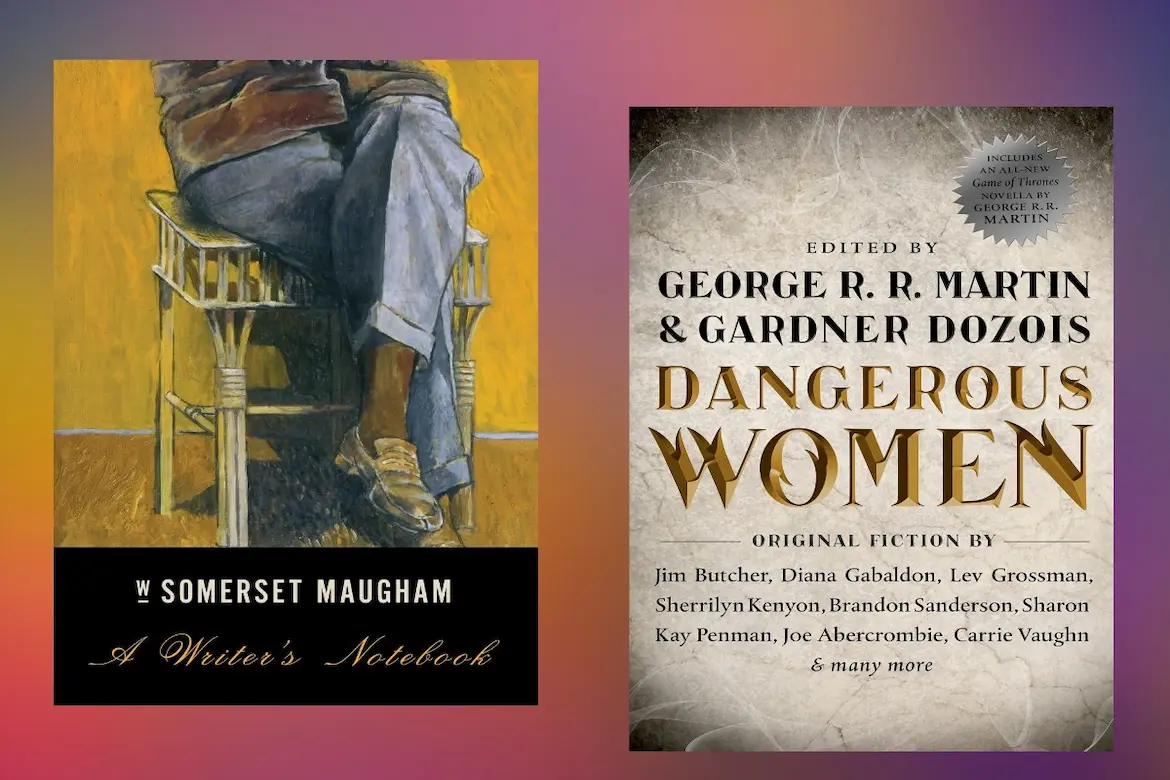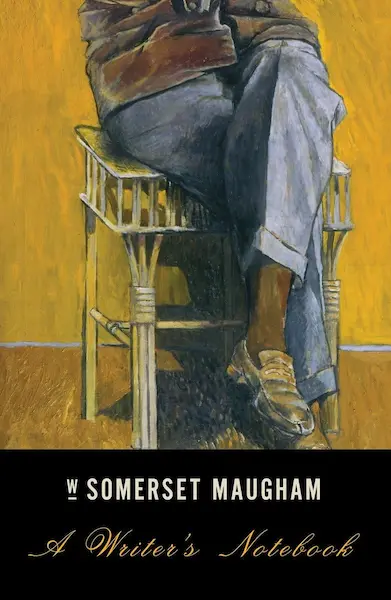In This LitStack Rec:
Introduction
This week, we are revisiting a LitStack Rec that recommends two books we know you would love to read. The first Rec, “A Writer’s Notebook” looks at why a notebook can be a best friend to a writer or to anyone wanting to manifest interior thoughts into living, breathing realities on the page. The second Rec, “Dangerous Women,” is self-explanatory. Who does not want to read about dangerous women? The world needs more dangerous women. We hope the book inspires you, and we hope you enjoy these Recs and that you add them to your growing TBR list.
~ J.S. Hood
A Writer’s Notebook by W. Somerset Maugham
Like most writers, I keep a notebook. It’s small and transportable, since the point is to record in the moment—things seen in passing, or sentences that arise unexpectedly, the kind that must be put down before they vanish. I also like to keep track of words, ones unexpectedly found in the passage of a book or overheard in conversation, in hopes they might be of use in a current or future piece of writing. My brand of note-keeping is strictly utilitarian. The entries don’t hold up on their own.
My notebook is more like a sketchbook, a record of fragments, images and ideas that in the moment glimmered up from the stream. One can only hope they’ll be useful later on.
My quotidian process is far from the careful notations made daily by Somerset Maugham, an extract of which was published in 1949 as A Writer’s Notebook. Maugham’s work has fallen out of fashion, but in his day, the author achieved wild success, outselling contemporaries including Joseph Conrad and Robert Louis Stevenson. The Guardian called Maugham “the first superstar novelist.” At the age of twenty, his plays were hits on the West End and later on, his novels were bestsellers, including The Razor’s Edge and Of Human Bondage. Never having received critical acclaim, Maugham once observed his gifts may have been a result of what he considered a talent for “the colloquial note.”
And yet, in these entries, the colloquial is keenly observed. In the volume’s introduction, Maugham writes, “I forget who it was who said that every author should keep a notebook, but should take care never to refer to it.” Daily note-making, he goes on to say, is essential for distinguishing the striking impressions from the “incessant stream of impressions that crowd across the mental eye.” A practice that sharpens the eye, and the prose:
“When you know you are going to make a note of something, you look at it more attentively than you otherwise would, and in the process of doing so the words are borne in upon you that will give it its private place reality.”
The entries range widely, from proverb-like determinations, to authoritative pronouncements on the contemporaneous—on people, places, and things. There are longer entries too, meditations on ideas and events, such as Maugham’s refusal upon being asked to write on France for the French press, or his observation that American males have “acquaintances but few friends.”
The book contains longer entries, often a few pages in length—scenes realized in and of themselves, such as the one that begins, “The Secret Agent. He was a man of scarcely middle height, but very broad and sturdy…” Or a two page entry on Maugham’s experience of early reading, which includes the novels Anna Karenina, Crime and Punishment, and the stories of Guy de Maupassant and Chekhov.
There are brief entries too. In this vein, Maugham would be right at home on Twitter, enlivening the feed the way Alain de Botton, Teju Cole and Joyce Carol Oates do. Fragments, ideas, observations, the Notebook has plenty, such as these stand-alone entries:
Radiant with health, like the persons of Venetian pictures in which the glory of living seems so comfortable a fact.
Each youth is like a child born in the night who sees the sun rise and thinks that yesterday never existed.
If it were possible decently to dissolve marriage during the first year not one in fifty couples would remain united.
Many of the entries are passages written to clarify the process of writing, on inspiration, craft, and in Maugham’s case, the vagaries of success—which found a way to plague the author despite the notoriety he achieved in his lifetime:
Readers do not know that the passage which they read in half an hour, in five minutes, has been evolved out of the heart’s blood of the author. The emotion which strikes them as “so true” he has lived through with nights of bitter tears.
At times, the language can feel dated, with a certain mustiness of the author’s milieu, the early-twentieth century British upper classes, but all the same, A Writer’s Notebook can be read in any sort of order. Randomly opening the book to any page is virtual guarantee that you’ll be immersed into the writer’s stream of thought—such as this gem:
…with Chekhov you do not seem to be reading stories at all…you might think that anyone could write them, but for the fact that nobody does.
The entries in this edition date from 1892, during Maugham’s youthful training as a medic in London, through 1944, the year his companion Gerald Haxton died, and to whom the book is dedicated.
—Lauren Alwan
Other Books by W. Somerset Maugham
Dangerous Women, edited by George R.R. Martin and Gardner Dozois
A nice, fat volume of short stories and novellas about dangerous women? Yes, please!
You know what the best thing is about a nice, fat volume of short stories and novellas about dangerous women (other than the fact that the stories are about dangerous women!)? You’re not obligated to read them all if you don’t want to – it’s perfectly fine if you do and it’s perfectly fine if you don’t. Ah, the freedom!
And this nice, fat volume has so very many substantial and varied short stories and novellas about dangerous women – 21 of them! Although its contents come from some of the biggest names in the science fiction and fantasy genres (such as Jim Butcher, Diana Gabaldon, Megan Lindholm even a “Game of Thrones” prequel novella by George R.R. Martin), it truly is a “cross-genre anthology”, including the future, the past, fantasy, romance, westerns, history, magic and yes, even a touch of the paranormal.
Reading through this book, I had a few favorites I’d like to share with you. Right out of the starting gate, “Some Desperado” by Joe Abercrombie told the story of Shy, a female outlaw on the run from both the law and her former gang, and it was fantastic: gritty, sharp, clever and desperate. History is wonderfully represented by “Raisa Stepanova” by Carrie Vaughn, about a female pilot in the Russian air force during World War II, and Sharon Kay Penman’s story about Constance de Hauteville, a real 12th century Sicilian queen in “A Queen in Exile”.
A bit of suspense and levity is bantered about in Lev Grossman’s return to Brakebills (the American academy for wizards which is the setting for his “Magicians” trilogy), when a young wizard’s prank gets caught up in consequences a thousand years in the making in “The Girl in the Mirror”.
But my absolute favorite was Nancy Kress’s “Second Arabesque, Very Slowly”, a simply astounding short story set in the dystopian future where a group of no nonsense survivors in a ruined New York experience a whisper of unexpected, forgotten beauty. It’s haunting and achingly lovely.
With all these wonderful stories to choose from, you just can’t go wrong – with any or all of them!
—Sharon Browning
Other Books by George R.R. Martin
Other LitStack Resources
Be sure and look at our other LitStack Recs for our recommendations on books you should read, as well as these reviews by Lauren Alwan, and these reviews by Sharon Browning.
As a Bookshop, BAM, Barnes & Noble, Amazon, and Lumas affiliate, LitStack may earn a commission at no cost to you when you purchase products through our affiliate links.



